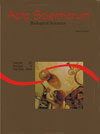<b>Ecologia da comunidade de metazoários parasitos do acará <em>Geophagus brasiliensis</em> (Quoy e Gaimard, 1824) (Perciformes: Cichlidae) do rio Guandu, Estado do Rio de Janeiro, Brasil</b> - DOI: 10.4025/actascibiolsci.v28i4.406
Resumo
Foram estudados 50 acarás Geophagus brasiliensis (Quoy e Gaimard, 1824) provenientes do rio Guandu, coletados próximo ・barragem da Estação de Tratamento de àgua (ETA) (22º48’32”S, 43º37’35”O), no Estado do Rio de Janeiro, no período de dezembro de 2004 ・novembro de 2005. Nove espécies de metazoários parasitos foram coletadas. O digenético Posthodiplostomum macrocotyle Dubois, 1937 (metacercária) foi a espécie mais prevalente (88%) e com a maior intensidade média (12,4), sendo a maioria dos espécimes encontrados parasitando os olhos, seguida pela metacercária Austrodiplostomum compactum (Lutz, 1928) e pelo hirudíneo Glossiphoniidae gen. sp., que apresentaram prevalências de 14% e 10%, respectivamente. Nenhum parasito apresentou correlação significativa entre o comprimento total do corpo do hospedeiro e sua prevalência. Posthodiplostomum macrocotyle apresentou correlação significativa entre o comprimento total do corpo do hospedeiro e sua abundância. O sexo dos hospedeiros influenciou a abundância de P. macrocotyle, A. compactum e Glossiphoniidae gen. sp., sendo as fêmeas as mais parasitadas. A riqueza parasitária apresentou uma média de 1,24±0,69 (0-3). Os parasitos apresentaram um padrão de distribuição agregado.Downloads
DECLARAÇÃO DE ORIGINALIDADE E DIREITOS AUTORAIS
Declaro que o presente artigo é original, não tendo sido submetido à publicação em qualquer outro periódico nacional ou internacional, quer seja em parte ou em sua totalidade.
Os direitos autorais pertencem exclusivamente aos autores. Os direitos de licenciamento utilizados pelo periódico é a licença Creative Commons Attribution 4.0 (CC BY 4.0): são permitidos o compartilhamento (cópia e distribuição do material em qualqer meio ou formato) e adaptação (remix, transformação e criação de material a partir do conteúdo assim licenciado para quaisquer fins, inclusive comerciais.
Recomenda-se a leitura desse link para maiores informações sobre o tema: fornecimento de créditos e referências de forma correta, entre outros detalhes cruciais para uso adequado do material licenciado.












1.png)




3.png)













